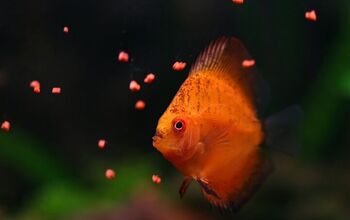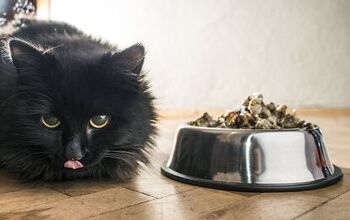How Often Should I Feed My Cat?

Feeding your cat is one of the most basic responsibilities as a cat parent, but it’s more than just opening a can or pouring some kibble into a bowl. Your cat’s food is the fuel that powers them through their lives with you.
Understanding their nutritional needs and establishing an effective feeding schedule is a key consideration for their overall health and well-being. This includes providing the right amount of food at the right time. But there isn’t a “one-size-fits-all” solution to mealtime. Instead, you’ll need to figure out how to meet your cat’s unique needs.
In this article, I’m going to share the most important factors to consider when deciding how often and how much to feed your cat, signs your cat needs a change, and tips for establishing (and sticking to) a feeding schedule that suits both you and your cat.
General Feeding Guidelines
While there is no universal rule for feeding, there are guidelines that can serve as a starting point for deciding on the best plan for your cat. These are general guidelines based on the average healthy cat. However, they shouldn’t be taken as set in stone.
The general guidelines, as set out by most experts (including VCA Animal Hospitals), are:
- Kittens 8 weeks – 6 months old: Feed approximately 5 meals/day to accommodate their tiny growing stomachs
- Kittens 6 months old and adults: Can be fed larger meals and reduced to as few as 2 meals/day, no longer than 12 hours apart
- Kittens should be transitioned to adult cat food at approximately 8-10 months old
Of course, you will need to adjust your cat’s feeding routine based on several factors, ranging from their overall health to your lifestyle. If you’re unsure what the right approach is for your cat, I recommend speaking with your veterinarian or a pet nutritionist.
Factors That Affect How Much to Feed Your Cat
I have mentioned the many factors that can impact the right amount and frequency when feeding your cat. These factors cover many aspects of your cat’s life, including their health, age, lifestyle, and more. Here are the factors I consider when feeding my cats:
Age
There are stages in a cat’s life where they will naturally need a higher or lower calorie intake. Kittens, while growing, need the calories necessary to support their growing bodies. However, if you continue to feed that same amount as an adult cat, it can lead to weight gain and possibly obesity ( an ongoing problem in the US).
At the same time, as a cat moves into their senior years, their body starts to slow down. At this stage, you need to adjust their nutrition to better suit their changing needs.
Size/Breed
Some cat breeds will naturally grow larger than others, requiring more calories to support their size. The best-known large cat breeds are the Maine Coon and the Norwegian Forest Cat. Of course, their size may be impacted if your cat is a mixed breed. I have a Maine Coon mix who is less than 7 lbs because she wasn’t blessed with the Maine Coon size.
Weight
You will need to adjust your cat’s meal depending on their current weight in relation to what is considered healthy. If your cat is overweight, you may need to cut back on how much or how often they are fed to support their weight loss. On the other hand (or paw) if your cat is underweight, you may need to strategically increase their calorie intake by feeding more each meal or feeding them more frequently.
Activity Level
Do you have a high-energy cat? Breeds like the Bengal are well-known for their playful and adventurous nature. Trying to fuel a higher-energy cat means that you will need to adjust their diet accordingly. However, if your cat is more laid-back and relaxed, feeding them more than necessary can cause them to gain weight.
Health Conditions
Anytime someone offers general guidelines for best feeding a pet or meeting their exercise needs, these guidelines are based on an average healthy pet. However, there are many health conditions that could impact your cat’s dietary needs.
Conditions affecting how your cat absorbs nutrients from their diet may require a cat to eat more to meet their basic nutritional needs. Some health issues will also cause your cat to gain weight easier, meaning you need to restrict their diet. Or they may have specific needs related to exactly what you’re feeding or how much they can eat at any given time.
When it comes to health-specific requirements, it’s best to speak with your cat’s veterinarian. They are familiar with your cat’s health history and can make recommendations that are best suited to keep them healthy and happy.
Food Type
Do you feed you cat wet food or dry food? Some foods are more calorie-dense than others, which can impact how often your cat needs to eat. Wet foods generally have a higher moisture content, making them less-calorie dense. A smaller portion of these foods can make your cat feel full. If your cat eats a diet primarily of kibble, they often need to eat smaller amounts to achieve the same level of calories and nutrition.
Your Schedule
Your cat’s health and well-being should be the primary concern when deciding on their feeding schedule, but I would be lying if I said that your schedule doesn’t also play into your decision. For example, if you have a hectic work schedule, it may be harder to accommodate multiple smaller meals.
There are tools that you can use to help overcome these challenges. Many cat parents use automatic feeders like the Cat Mate C300 Automatic Digital Pet Feeder to offer meals on time, even when they are stuck at the office.
Meal Feeding vs Free Feeding
Deciding whether to free-feed your cat (leaving a dish out for them to graze as they feel inclined) versus feeding based on set mealtimes can be difficult with no “right” answer. The same factors that impact how much or how often your cat should eat can also affect which of these solutions is best.
Meal feeding means giving your cat specific portions of food at set times throughout the day. This makes it easier to control how much your cat is eating, making it the ideal choice for cats who need to lose weight or those who need help regulating their sugar levels. Meal feeding is also the perfect choice for cats who lack willpower when food is available (like my cat Jinx).
For those who choose meal feeding, it will require sticking to a strict schedule yourself. You will either need to provide food to your cat on a set schedule or use an automatic feeder.
Free feeding is the easier option for cat parents. This means leaving a bowl of food out for your cat to enjoy as they feel inclined throughout the day. As convenient as this is, it can make it difficult to monitor how much your cat is eating each day – especially if you live in a multi-cat household. This can also be difficult if you are feeding fresh food (raw or wet food) as it will spoil when sitting out for too long.
Signs Your Cat Needs a Change to Their Feeding Routine
As cat parents, we do everything possible to make the best choices for our cats. Unfortunately, there are times that we will find that what we thought was best isn’t actually in their best interests. We may realize this while educating ourselves on the topic and applying more information to the topic or by noticing signs that something isn’t working for our cat.
Some of the most common signs your cat’s current feeding routine isn’t working include:
- Excessive begging for food
- Vocalization (meowing, chattering, or yowling)
- Nausea, vomiting, or diarrhea
- Weight gain or loss
- Dull, lifeless coat
- Lethargy or loss of energy
If you notice any of these signs of trouble, it’s time to revisit your decisions. You may need to increase or decrease how much your cat is eating each meal, divide your cat’s meal into more or fewer meals, or even reconsider what food you are feeding. If you’re unsure of what changes are necessary, contact your veterinarian to discuss your concerns.
Tips for Creating (And Sticking To) a Feeding Schedule
Consistency is Key
The most important part of creating and sticking to a cat feeding schedule is consistency. You want to stick to as tight a schedule as possible with your cat to give them the security of knowing when their next meal is coming. If this is something you struggle with, or if you are trying to work with a family to accommodate this routine, try using alarms or the calendar on your phone/the phones of your family members to keep everyone on schedule.
Observe Your Cat’s Habits
Pay careful attention to what your cat is telling you. They can’t speak English to let you know if something is or isn’t working. They can’t ask for food if they are feeling hungry. However, they can use body language and other verbal and non-verbal communication skills to let you know something isn’t working with their current routine.
Consider Dishes vs Interactive Feeding
For cats with a bad habit of excessive eating (eating more than they need), a great solution is incorporating some form of mental enrichment into their mealtime routine. Food puzzles or interactive toys will challenge your cat to use their natural hunting and foraging skills. This not only helps them burn excess energy but can also address the boredom that often leads to excessive eating while allowing them to feel fulfilled with a smaller portion of food.
Incorporate an Automatic Feeder
If you find your cat is inhaling their food, but you aren’t around to provide a puzzle feeder or to monitor how much they are eating during the day, an automatic feeder is a great solution.
There are many different types of feeders, each designed for different types of food. For example, the PetLibro Automatic Cat Feeder will dispense a set amount of dry food at a time for up to 10 meals per day. However, if you’re feeding wet food that needs refrigeration, you may be better served by the Cat Mate C300 that I mentioned before, which incorporates an ice pack to keep food from spoiling and is available in 3 or 5 meal options.
Final Thoughts: How Often to Feed Your Cat
Feeding your at isn’t a one-size-fits-all approach. Instead, as cat parents, it’s our job to understand the many factors that could include our best friend’s nutritional needs and create a feeding routine that best focuses on their health and well-being.
Remember, their age, breed, activity level, and any health conditions they live with all affect how much and how often they should eat.
Contact your veterinarian or a pet behaviorist if you’re unsure where to start when creating your cat’s feeding routine. They can provide personalized advice and guidance to accommodate your cat’s unique needs. Keep an eye on your cat’s behavior for signs that their current routine isn’t working for them.
With a little preparation, research, and ongoing adjustment, you can create and stick to a feeding routine that keeps your cat happy, healthy, and purring with contentment.
Join the PetGuide community. Get the latest pet news and product recommendations by subscribing to our newsletter here.

Britt Kascjak is a proud pet mom, sharing her heart (and her home) with her “pack” which includes her husband John, their 2 dogs – Lucifer and Willow – and their 3 cats – Pippen, Jinx, and Theia. She has been active in the animal rescue community for over 15 years, volunteering, fostering and advocating for organizations across Canada and the US. In her free time, she enjoys traveling around the country camping, hiking, and canoeing with her pets.
More by Britt
























